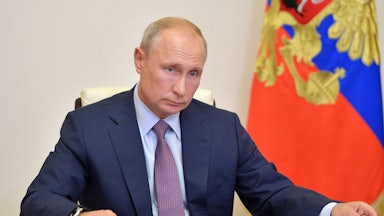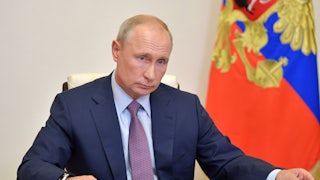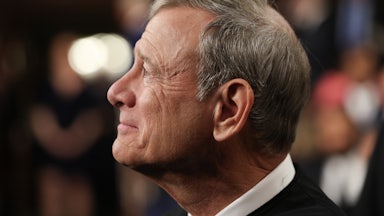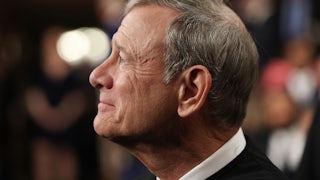Europe is once again on the edge of war. The unthinkable is all too thinkable: a major conflict on European soil with the unpredictability, the combustibility, and the ultimate futility of an extended military clash. Should Russia attack Ukraine in the coming weeks or months, the war might be contained within the territory of Ukraine. Even so, it would destabilize Ukraine’s European neighbors—Romania, Bulgaria, Hungary, Slovakia, and Poland. Each is a NATO member to which the United States has given an “Article 5” commitment, obliging us to act in mutual defense of member nations. The U.S. waited some three years to enter World War I and was pulled into World War II two years after it had begun in Europe. This time there would be no such insulation from the overseas conflict, no such delay. The U.S. would be affected immediately.
Whether or not a wider war comes to Ukraine, the U.S. is staring (almost in disbelief) at a new world in Europe. The pitch of uncertainty is new, the fault lines are new, the actual and potential dangers are new. By contrast, the Cold War in Europe was relatively staid. West Berlin was never a settled affair, but elsewhere the Iron Curtain separated East from West. Precisely because Europe was impossible to rearrange during the Cold War, the U.S. and the Soviet Union fought each other through proxy wars in Asia, the Middle East, Africa, and Latin America. Now Russia and the U.S. are contending with each other in a Europe that has no Iron Curtain.
Containing this conflict, if possible, will demand of the U.S. great diplomatic deftness. Washington will be obligated to follow an intricate via media between the preservation of state sovereignty, especially that of “small” countries, of which Europe has many, and the prevention of an outright U.S.-Russian war. It will not be easy. Deciphering and responding to Putin’s future course of action amounts to a terrible challenge for the U.S.
At some point in 2021, a diplomatic status quo some seven years in the making fell apart. It concerned the destiny of Ukraine, which had emerged from the collapse of the Soviet Union in 1991. It is a territorially large nation of some 40 million people lodged in the geographic heart of Europe. Post-Soviet Ukraine had vacillated between Russia and the West. Then in 2014, a mass uprising toppled a government that leaned toward Russia. In the ensuing chaos, Russia annexed Crimea and invaded Eastern Ukraine. Russia won its military battles easily, while in many ways losing the war. A pro-Russian government did not come back to Ukraine. Ukraine ceased vacillating between East and West. Russia’s interventions garnered Ukraine considerable sympathy in the West. Over time, that sympathy translated into meaningful financial and military support.
Diplomacy is an impermanent art at best, and the diplomacy in question was oddly inconclusive from the beginning. Prior to the winter of 2021, Ukraine could not be classified as either a failure or a success for the West. After 2015, when the fighting tapered off, Ukraine did not lose any further territory to Russia. It also retained its political pluralism and its vibrant civil society, symbols of its preferred European orientation. Under difficult circumstances, Ukraine was muddling through. It fell short of a success, though, in that the often promised era of political reform never arrived. A subservient judiciary continues to allow the executive branch to annul the rule of law. Power remains in the hands of oligarchs as much today as before Ukraine’s 2014 “revolution of dignity.”
Ukraine’s foreign policy aspirations were a tangle of contradictions after 2014. They were pegged to the acquisition of NATO membership, even though NATO had no intention of welcoming Ukraine into the alliance. The U.S. and other Western countries were happy to affirm Ukraine’s “Euro-Atlantic integration”—a misnomer for a country on the Black Sea—but given Russia’s opposition to such integration, it was unclear how meaningful this affirmation was. Was it sincere? Would the West go to bat for Ukraine? Or was this just rhetoric?
By the time Joe Biden arrived in the Oval Office, the West’s attitude toward Ukraine was benign neglect. (Trump had been impeached for his malign interest in Ukraine.) On the one hand, the West would not exert extra pressure on Russia where Crimea and Eastern Ukraine were concerned. Gradually, “business as usual,” which was supposed to have been invalidated by Russia’s 2014 intrusions into Ukraine, became possible again. Germany allowed construction of an energy project with Russia, the Nord Stream 2 pipeline, to go forward. Various European leaders met with Putin without rancor.
In June 2021, Biden himself sat down with Putin in Geneva, seeking greater stability in the U.S.-Russian relationship. No concessions were given to Russia. The economic sanctions imposed in 2014 were not lifted. NATO refused to shut its open-door policy, which stipulated that any country might join the alliance. Under Biden the military relationship between Ukraine and the West continued to develop along the lines established by the Trump administration, which had been sending it military aid. By 2021, Ukraine had become a not-yet-resolved but entirely acceptable diplomatic problem for the West. For Russia, however, it was a not-yet-resolved and entirely unacceptable diplomatic problem.
Putin’s mind is notoriously hard to read. Yet we know he changed it in 2021. He initiated a military buildup around Ukraine that in and of itself will redefine Europe. Even more consequentially, Putin has placed substantial military resources in Belarus, a nominally independent country ruled by an erratic dictator, Alexander Lukashenko. In the last few weeks, Russia has annexed Belarus, in deed if not in word. If these troops and this equipment remain in place, Ukraine will be on the verge of mortal peril, and a handful of other countries—Poland, Latvia, Lithuania, and Estonia, all of which are NATO members—will feel endangered. Their newfound sense of insecurity will inevitably push them toward Washington, London, Paris, and Berlin for assistance in pressuring Russia, an outcome Putin had to have predicted before deciding on his military buildup around Ukraine.
In late 2021, having altered Europe’s military balance of power, Putin changed gears diplomatically. In the past, Russia has been perfectly capable of normal diplomacy. The Obama administration could not have reached a deal with Iran had Russia not provided its steady and helpful support. Putin’s June 2021 meeting with Biden was professional and above-board.
After June 2021, however, Putin upped the ante dramatically. In the midst of his military buildup, he confronted the West with a set of demands so severely worded that they amounted to ultimatums. He wanted—or so he claimed—the West to backtrack publicly on Ukraine’s joining NATO. He wanted NATO itself to pull back, and he wanted a response to his demands as soon as possible. Such gonzo diplomacy is not just unusual in Europe, land of technocrats and of slow-paced verbal reshuffling: It is unusual for Russia and interestingly inconsistent with Putin’s previously stated aim of gaining greater international respect for Russia. He has swapped out the quest for respect with demands to be heard. As never before, he has gotten the West’s attention.
How best to read Putin’s mind at the moment? The use of military force or the threat of force typically signifies diplomatic failure. In the last few months, Putin has tacitly conceded the shortcomings of his prior approach to Ukraine. He has not persuaded or compelled the Ukrainians to produce a pro-Russian government or even one that would tolerate a neutral Ukraine. Nor has Putin gotten the West to back off. New fissures have appeared in the Republican Party, and the populist right in the U.S. and elsewhere seems to prefer Putin’s authoritarianism to the political spirit of the European Union.
But that meant little when President Trump was in power. Trump hardened U.S. policy toward Russia. Meanwhile, Russia’s meddling in the 2016 election poisoned his relationship to the Democratic Party. This constrains what President Biden can do in office, although Biden’s intent has been at most to manage conflict with Russia and not to give Russia what it wants in Ukraine. Putin’s radicalism at the present moment speaks to his frustrations with the status quo. And amid all the uncertainties, one thing is clear: Putin is going to alter this status quo.
A wider war being unfathomably risky for Russia, Putin will first try to exert pressure and see what concessions he might extract. The U.S. is not going to blink, and neither will Ukraine, but Europe is full of wild cards, of internal divisions on Russia (and on Ukraine) that might lead some European countries to offer concessions in order to prevent a major European war. Putin may even expect a country or two—Hungary or Croatia or Greece or Cyprus—to separate from the U.S. and weaken the united transatlantic front that has thus far stopped Putin from rocking the boat. Absent this not very likely turn of events, Putin may opt for military action as his best means of destroying the status quo and of seeing in which direction he can maneuver Russia. He may see the West as more prone to internal destabilization than Russia and as incapable of rising to the challenge of containing a nuclear power with Europe’s biggest conventional army. If so, Putin would be making an astonishingly high-stakes bet.
In Ukraine, the Biden administration has no good military options. Ukraine is not an ally of the U.S., and for Washington to involve itself directly in the ongoing war between Ukraine and Russia would be to cross a line that was never crossed in the Cold War. The Soviet Union and the U.S. fought proxy wars during the Cold War, they spied on one another, and they did ceaseless ideological battle, but they did not kill the others’ soldiers in uniform and with their own weapons.
If a U.S. soldier were to kill a Russian soldier in Ukraine—or vice versa—there would be little chance of preventing an escalatory spiral pushed forward by social media and public sentiment. The Cuban missile crisis was a discrete episode in which soldiers did not die. A shooting war between the U.S. and Russia would be vastly more dangerous than the Cuban missile crisis. It could be resolved only by one side backing down, which is not something that nuclear powers are typically willing to do. More likely, it would lead to a nuclear exchange.
But the U.S. cannot simply act as a bystander in this unfolding conflict. The U.S. has forged a partnership with Ukraine. It has made commitments; these commitments have consequences. Especially in the wake of the pullout from Afghanistan, the U.S. cannot afford simply to give up on its partner.
Moreover, Ukraine matters as precedent. If Russia can “successfully” invade and either incapacitate or partition a European state, then Europe is back where it was before the Second World War, its borders uncertain and its more vulnerable countries subject to the brutalities of might-makes-right. This would transform Europe, the shining success story of American diplomacy in the 1990s, into a kind of battlefield, to the great detriment of the Europeans and to the detriment of American policy. The U.S. would have to pivot back from Asia to Europe. Many of the achievements of the EU, its contributions to peace and prosperity, would be shrouded in a cruel uncertainty.
In the fog of not-yet-war, the U.S. should focus on three priorities. First, it should pursue the most ambitious possible diplomacy with Russia. It cannot give in to Russia’s demands. It can indicate, though, that if Russia is willing to forgo a wider war in Ukraine that the U.S. would be open to a diplomatic conversation not entirely on Western terms, a conversation that is not defined by NATO’s terminology alone and that is receptive to new ideas, to creativity, and to rethinking the status quo in tandem. The U.S. should also prepare to contain the ripple effects of a major war in Ukraine, if one comes to pass, by reassuring regional allies from the Baltic Republics to the Balkans to Turkey, by preparing to deal with the humanitarian fallout of war—and if necessary, by preventing NATO members from going to war in Ukraine individually.
Finally, if war comes, massive sanctions will be imposed on Russia, as they should be. Russia will retaliate—quite possibly in the cyber domain. At that point, the U.S. will have to find ways to calm the situation down and to ensure stability, a quality that was difficult to find when the Biden administration first started to look for it and has recently become a lot more elusive. Yet an overall stability is not less necessary today than it was when Biden became president in January 2021. It will remain equally necessary in the months to come.










